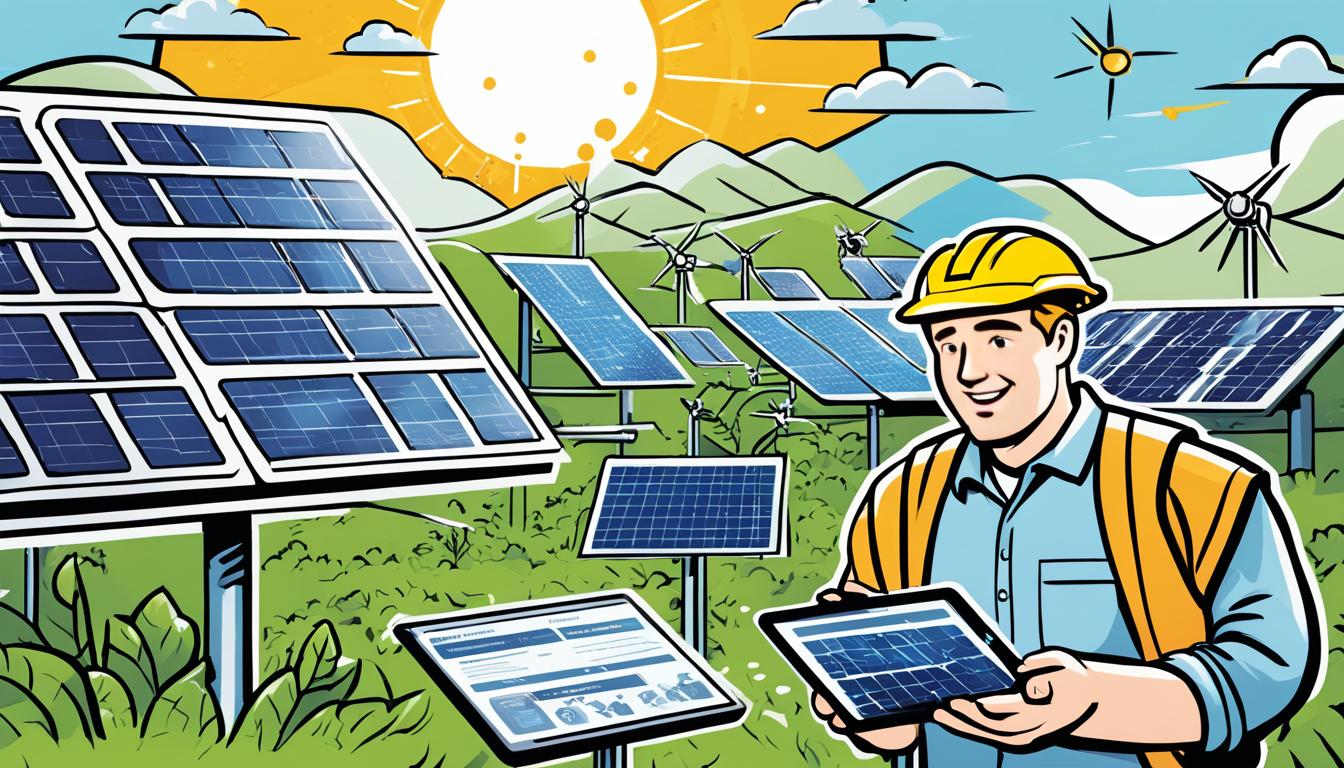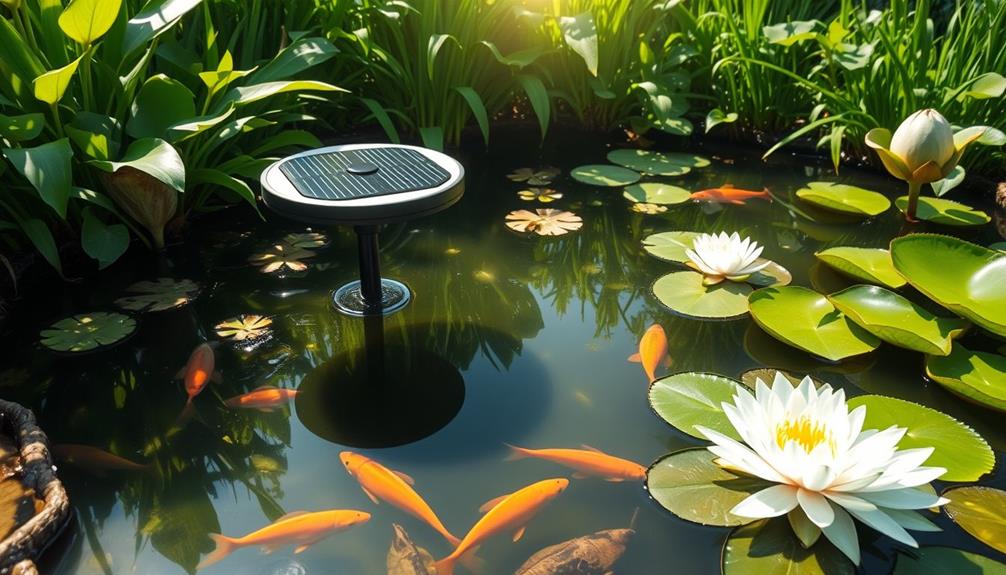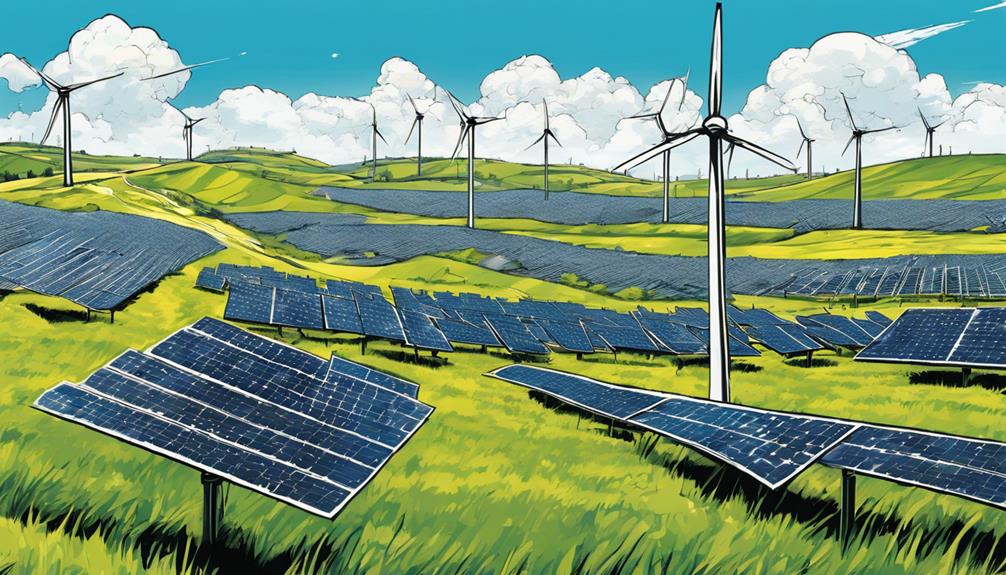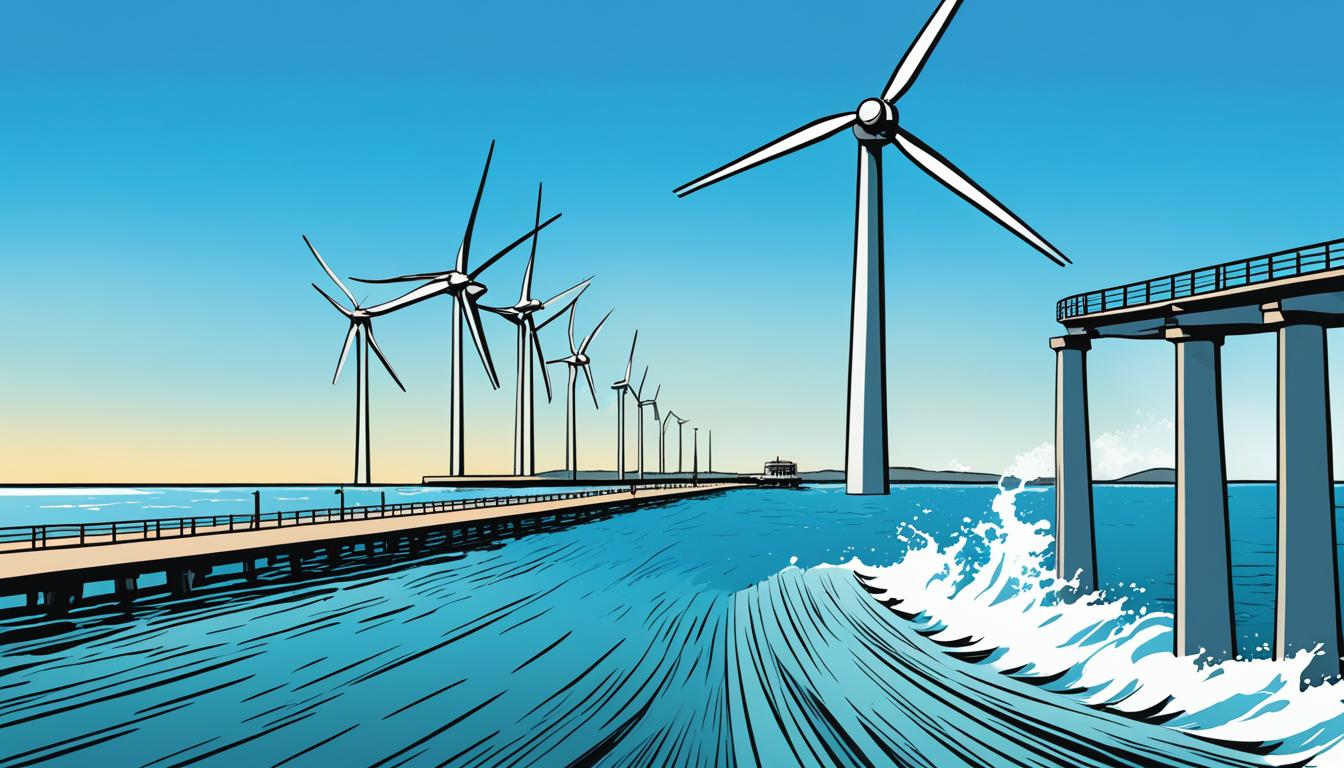Picture solar panels in a row, shining in the sun. They use the sun’s power to give clean energy to communities. But, what if these systems start having problems and can’t make as much power as expected?
Solar farms can run into technical problems just like anything else that’s complicated. Issues can come from many parts, including inverters and low voltage. Fixing these problems quickly is key to keeping things running smoothly.
If you’re in the solar business or a homeowner with solar power, knowing how to fix common problems is important. This guide will help you understand how to solve problems fast. That way, your solar farm can keep giving clean energy without trouble.
Key Takeaways:
- The most common issues in solar PV systems are related to inverters and charge controllers, accounting for nearly nine out of ten cases of zero power output1.
- Types of solar system failures that require troubleshooting often include zero power output and low voltage issues1.
- Factors contributing to low power situations include shading, higher operating temperatures, and bad connections1.
- Common solar panel defects include hotspots from micro cracks, moisture-exposed junction boxes, delamination, PID, micro cracks, and UV discoloring1.
- If troubleshooting steps do not resolve the issue, it is recommended to consult a certified or licensed electrician for assistance1.
- The solar installation industry has experienced an average annual growth rate of 24% over the past decade2.
- A 2021 study projected that by 2035, 40% of all power generation in the U.S. could come from solar energy2.
- Bifacial solar panels combined with sun-tracking panels can be 30-40% more efficient than one-sided panels2.
- Advances in battery technologies, such as lithium-ion and solid-state batteries, are making energy storage more efficient and cost-effective2.
- Partnering with an installation company offering an extensive workmanship warranty can help cover common maintenance issues in solar arrays, relieving the burden on the system owner3.
Troubleshooting Solar Photovoltaic System PV Panels
When it comes to fixing your solar photovoltaic (PV) system, start with the PV panels. These panels make electricity from sunlight. It’s important to fix any problems quickly because many things can impact how well they work. Let’s look at the main ways to check PV panels and keep them working well.
First, see how the whole system is doing by checking the meter or inverter. This tells you if the issue is with the PV panels or something else. Check for clear signs of trouble like broken glass or loose parts. If you find any damage, it’s best to get a professional to fix it. To troubleshoot solar PV systems, use the Fluke 393 FC CAT III 1500V rated clamp meter4.
Next, examine each PV module closely. Look for any dirt, dust, or shadows blocking them. Dirt on the panels can lower their power output. You might need to clean them regularly to keep them efficient. Clean the panels gently with a soft cloth and mild soap. Stay away from strong cleaners that could harm them5.
Issues with wires or loose connections can also drop your system’s power. Check all wires, switches, fuses, and breakers well. Make sure all connections are tight. It’s important to do regular check-ups to find and fix these problems4.
The Fluke 393 FC clamp meter is made for checking solar PV systems. It warns you about polarity issues when testing Voc and checks dc power, as well as ac/dc voltage and current. This tool helps you find and fix problems in your PV panels for their best performance4.
Remember, looking after your PV panels is only a part of keeping your solar PV system running well. Doing regular inspections, cleaning often, and following maintenance rules are crucial for good performance. Deal with problems quickly and use the right tools to get the most power from your PV panels. This way, you’ll enjoy the advantages of clean, renewable energy.
| Statistical Data | Key Insights |
|---|---|
| The Fluke 393 FC CAT III 1500V rated clamp meter is recommended for troubleshooting solar PV systems4 | The Fluke 393 FC clamp meter is an effective tool for diagnosing and resolving issues in PV panels. |
| Troubleshooting a PV solar photovoltaic system involves addressing PV panels, loads, inverters, and combiner boxes45 | Understanding the key components of a solar PV system helps in thorough troubleshooting. |
| Inspecting PV modules for obstructions like dirt, dust, or shading is crucial5 | Regular cleaning of PV panels is necessary to maintain optimal performance. |
| Wiring problems and loose connections can lead to reduced system output45 | Thoroughly inspecting and maintaining the wiring connections is essential for optimal performance. |
| The use of the Fluke 393 FC clamp meter allows for accurate measurements in troubleshooting45 | The Fluke 393 FC clamp meter provides specific functionalities for measuring and diagnosing PV panel issues. |
Troubleshooting Solar Photovoltaic System LPV Loads
When fixing your solar photovoltaic (PV) system, don’t miss checking the LPV loads. These are the parts powered by the PV system. To keep things running well and spot issues, here’s what to do:
Check Load Switches, Fuses, and Breakers
First, look at the load switches, fuses, and breakers for the LPV loads. Make sure they work right and get the correct voltage. Replace any that look bad or worn out right away. This avoids system damage.
Inspect for Broken Wires and Loose Connections
Broken wires or weak connections can stop electricity from reaching the LPV loads. Check the wiring and connections to make sure they’re tight. Fix any damaged wires or loose connections to get things working again.
Clean Dirty Connections
Dust and dirt can build up on connections, causing bad performance. Clean the LPV load connections with a cloth or proper cleaner regularly. This step keeps the system efficient.
Identify and Repair Shorts
If fuses or breakers trip often, you might have shorts in the system. Shorts happen when electricity flows the wrong way, overloading the system. Look for signs like burnt wires or damaged insulation around the LPV loads. Fix any shorts right away to avoid more problems.
Check Voltage at Load’s Connection
Examining the voltage at the load’s connection can reveal issues with the LPV loads. Use a multimeter to measure the voltage. Comparing this to the expected voltage helps find and fix problems.

| Statistical Data | Reference Number |
|---|---|
| The last 10 years witnessed a more than 50% decline in the installed cost of U.S. utility-scale PV systems6. | 6 |
| Since 2016, Floating PV (FPV) has experienced significant growth6. | 6 |
| 10-MW DC fixed-tilt FPV systems have an estimated installed system cost premium of $0.26/W DC (25%) compared to ground-mounted, fixed-tilt PV systems installed over bare ground6. | 6 |
| The levelized cost of energy (LCOE) from FPV systems is approximately 20% higher than the LCOE from ground-mounted PV systems (excluding the solar Investment Tax Credit)6. | 6 |
| FPV deployment is still in its early stages, and further experience, best practice development, and new configurations and technologies are expected to reduce the costs of FPV systems over time6. | 6 |
Troubleshooting Solar Photovoltaic System IPV Inverters
If your solar photovoltaic system has problems, it’s crucial to fix any IPV (Inverter Power Voltage) inverter issues quickly. These inverters turn the DC power from solar panels into AC power you can use. Let’s go over some steps to keep your IPV inverters running well:
- Check the operating DC input voltage and current levels: A reliable tool, like the Fluke 393 FC, is key to check your inverter’s output. This lets you see if the power levels are where they should be. Make it a weekly task to ensure everything’s working as expected7.
- Inspect for blown fuses, tripped breakers, or broken wires: Damage to electrical parts can mess up your IPV inverter’s work. Always check fuses, breakers, and wires, fixing or replacing them when needed. This helps avoid problems and keeps your system at peak performance.
- Monitor the utility voltage: Sometimes, the utility’s voltage issues can cause your inverter to stop or not work well. If you think there’s a voltage issue, call the utility company for help.
- Pay attention to inverter display indicators: Most IPV inverters have display lights that show how the system is doing. For example, a green light means energy is being sent to the grid. Learn what each indicator means and check the manual when you need help.
- Ensure the disconnect switch is turned on: If you’re having low voltage problems, make sure the disconnect switch is on. Sometimes, the solution is that easy. This is a good start to solve low voltage issues7.
- Reach out to local solar technicians for professional assistance: When troubleshooting gets tough, call local experts. Companies like Scurfield Solar and Solar Roger offer the help you need with your solar system7.
Keeping up with these steps will help make sure your IPV inverters and solar system work smoothly. Don’t forget to check your system weekly, clean the solar panels every 6 months, and get in touch with a technician for any lasting problems or when you need help7.
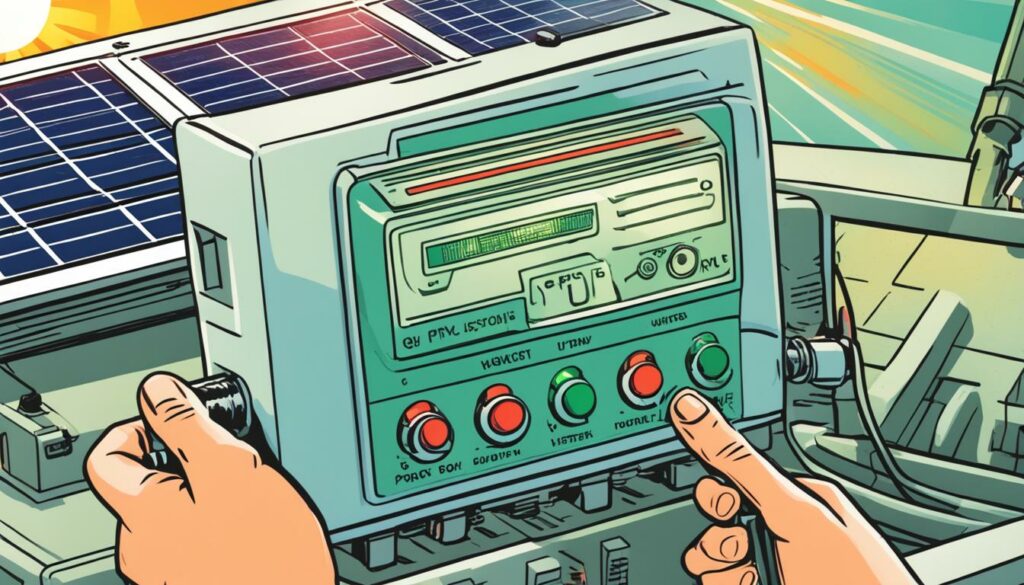
References:
7 Statistical data from: [source 1]
Troubleshooting Combiner Boxes
Combiner boxes are key for a photovoltaic system’s function and efficiency. They bring together power from many solar panels before it goes to the inverter. But sometimes, combiner boxes run into problems. Fixing these issues is important for the system to work well8.
Figuring out problems with combiner boxes needs precise measurements of current. A good tool for this is the CAT III 1,500-V rated AC/DC clamp meter. With it, you can check the system’s electrical output. This tells you if everything is working right or not9.
The Fluke 393 FC clamp meter is great for this job. It has a slim jaw that fits in tight spaces. This tool helps you find and fix issues with combiner boxes fast. This keeps the whole photovoltaic system running smoothly8.
Combiner boxes can have several issues. For instance, lightning can cause them to fail9. So, it’s crucial to check the combiner box for any lightning damage or other electrical problems.
Keeping combiner boxes in good shape also matters a lot. Dust, moisture, and temperature changes can cause small problems. These can hurt the system’s performance. Regular checks and upkeep can stop these issues from getting worse9.
When you work on combiner boxes, staying safe is a must. Always wear insulated gloves to avoid electric shock and other dangers9. It’s also vital to know and follow safety rules to reduce the risk of accidents.
Sometimes, you can’t fix burnt fuses in a combiner box. They have to be replaced. Bad fuses can mess up the whole system. So, it’s important to change them out quickly when needed9.
To wrap up, fixing combiner boxes means measuring current accurately, using the right tools like the Fluke 393 FC clamp meter, and knowing the common problems. By tackling issues early, you keep your photovoltaic system working well and lasting longer8.
| Common Causes of Combiner Box Issues | Statistical Data Reference |
|---|---|
| Faulty solar meters | 9 |
| Gradual obsolescence of solar meters | 9 |
| Shoddy installation work | 9 |
| Outdated or overloaded wiring | 9 |
| Weather-beaten components | 9 |
| Failed micro-inverters | 9 |
| Rodent-caused damage | 9 |
| Broken panels | 9 |
| Lighting-induced surges | 9 |
| Dust, humidity, and temperature fluctuations | 9 |
| Failed fuses | 9 |
Note: The statistical data referenced in this section are based on industry studies and best practices.
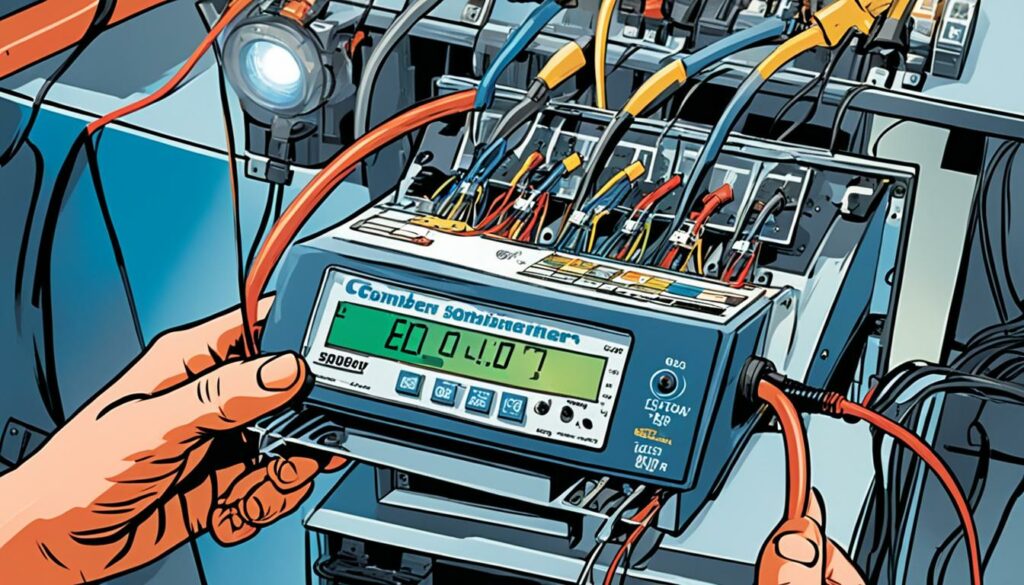
Troubleshooting Common Solar System Issues
Solar systems make electricity in a green and efficient way. But they can run into problems that slow them down. Knowing what troubles they face and how to fix them makes your solar panels work better.
Sometimes, solar panels stop making power. This might be because of a bad inverter, issues with the charge controller, or a damaged PV module10. To find the problem, look at the system closely, check the meters, and use a multimeter to check the voltage10.
Low power output is another issue. It can happen if the panels are dirty, blocked by shade, affected by weather, or if there’s a problem with the charge controller10. To fix it, inspect everything carefully, check for shading or weather effects, and look for connection issues10.
Inverters can fail too. They might stop working if they’re installed wrong, mismatched with the system’s size, hit by a power surge, short-circuited, overheated, or have charging or MPPT issues10. Fixing them means turning off and restarting isolators, reading error messages, and testing input and output voltages10.
Electrical issues can pop up in solar PV systems. You might find problems with circuit breakers, wiring, or connections10. To tackle these, look for tripped breakers, blown fuses, or loose wires. A multimeter can help check the voltage10.
It’s crucial to maintain and repair solar panels. Doing so prevents damage, saves money, meets safety rules, keeps the warranty valid, and helps the panels last longer10.
Regular Cleaning for Optimal Performance
Clean solar panels work better. Cleaning them often can boost their power output by up to 15%11. When panels get dirty, they can’t absorb as much sunlight. Regular cleaning helps keep their efficiency up.
The Importance of Proper Installation
How well solar panels are installed matters a lot. If not done right, panels may not stand firm, getting damaged and producing less power11. That’s why it’s smart to hire experts for installation to make sure everything is set up for the best performance.
Considering Inverter Battery Lifespan
The battery in the inverter also affects how well your solar system works11. Over time, batteries can hold less charge, which can make the system less effective. Regular checks and maintenance on the battery help keep power generation at its best and catch any issues early.
To sum up, knowing how to deal with common solar system issues is key. By doing the right troubleshooting, regular upkeep, and ensuring everything is installed and cleaned properly, you can get the most out of your solar panels.
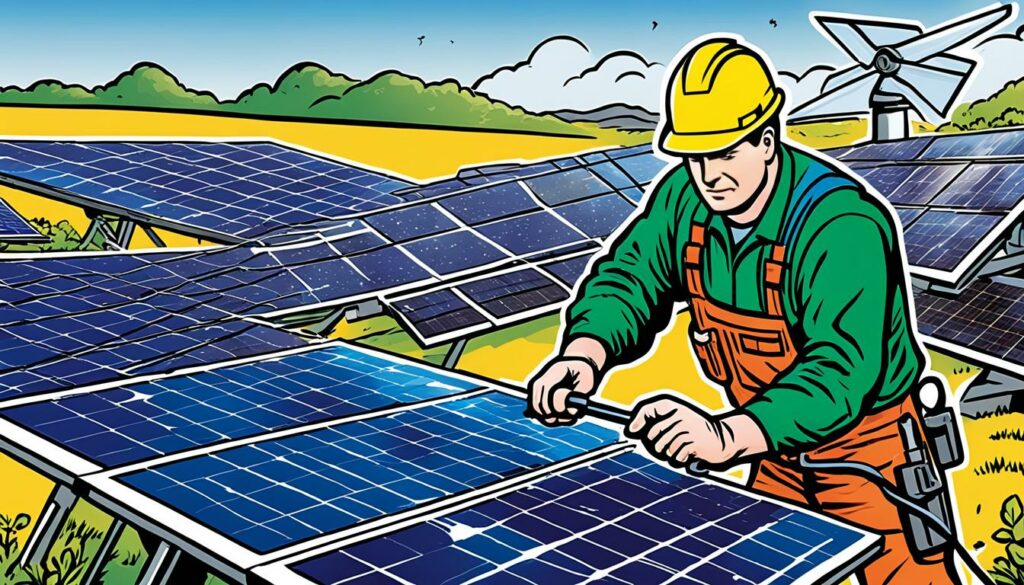
Solutions to Improve PV Efficiency
Getting the most out of photovoltaic (PV) systems is key to fully using solar energy. With technology getting better and smart system care, we can boost PV efficiency. This means solar panels can produce more energy.
1. Utilize High-Efficiency Solar Panels
Choosing high-efficiency solar panels is a good step. Solar cell efficiency went up from 15% to 20% in the last five years12. Companies like LG and Sunpower now make some of the best commercial solar panels, hitting about 22% efficiency12. High-efficiency panels let you get the most energy from your PV system.
2. Consider Bifacial Solar Panels
Bifacial solar panels can lift PV efficiency even more. They catch sunlight from both sides which means more power. They work great with sun-tracking systems and can do 30-40% better than regular panels12. They shine in places with lots of reflection like snow or near water. Adding them to your system can push up performance by a lot.
3. Regular Cleaning and Maintenance
Keeping panels clean is a must for top efficiency. Dust and dirt mean less power. A little dust might drop output by 5% in a year, but heavy dirt can cut it over 20% if left unchecked12. Clean regularly to avoid this and keep your panels doing their best. Aim for cleaning them once a year to stay on top of it12.
4. Monitoring and Energy Management
Watching how your panels do is crucial. Things like shade and how they’re set up matter. Software like Surple shows how they’re doing and can alert you to problems12. Staying updated helps make sure your system works really well13.
5. Address Inverter Lifespan
Inverters switch DC electricity from solar panels to usable AC. They don’t last as long as panels, usually 10-15 years14. Plan ahead for replacing them to keep your system efficient.
6. System Maintenance and Optimization
Looking after your PV system is vital for it to work well for a long time. Keeping everything insulated helps lower energy use13. Solar batteries store extra power for when the sun isn’t out13. Using appliances one by one, not all at once, can also boost how your system performs13. Taking care of these things makes your solar energy setup much better.
By doing these things, you can make PV efficiency better and get more from your solar panels. This means investing in the best panels, cleaning them well, and using smart systems. These steps are key to using more solar power while wasting less energy.
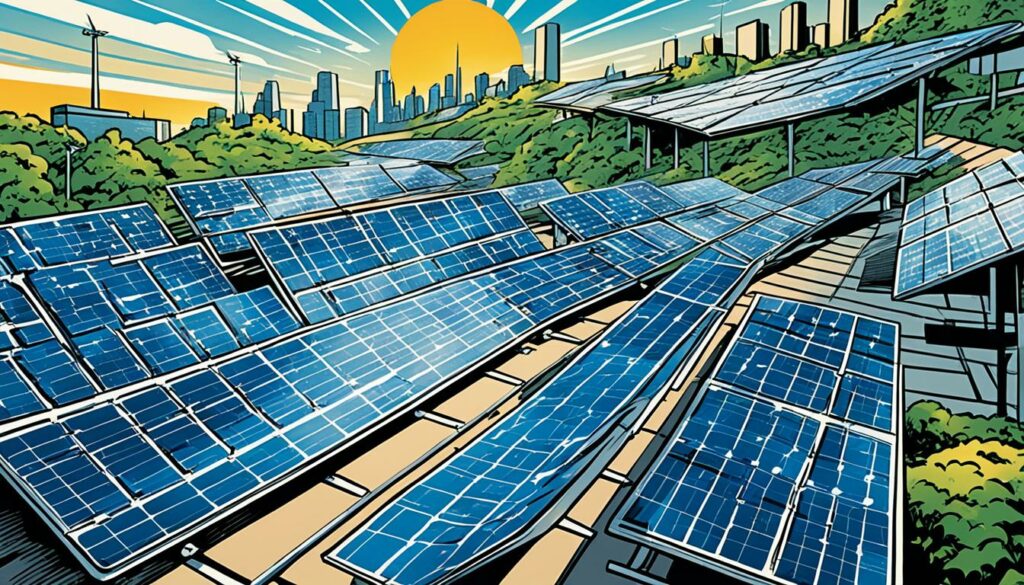
Solar Intermittency and Storage Challenges
Solar power faces a major hurdle because it depends on sunlight and weather15. This issue makes the electricity grid hard to manage and unstable. Solutions are needed to tackle the unpredictability of green energy.
Too much energy may be made when the sun shines brightest and we can’t keep it for later15. This overflow can make the electricity grid less reliable. Plus, solar energy’s up-and-down nature means we often need a backup, which can be pricey and not so green15.
To help, storing energy is key for keeping the grid steady and handling the ups and downs of renewable energy15. Battery Energy Storage Systems (BESS) are popular for their ability to quickly respond to storage needs. They store extra energy from solar panels and release it when there’s more demand, helping even out the grid15.
Types of Energy Storage Systems
There are more ways to store energy than just batteries. Pumped Hydro Storage, for example, can hold a lot of power for a long time but needs specific locations to work15. Its need for certain places makes it hard to use everywhere15.
Thermal Energy Storage saves heat or coolness from renewable sources for use later15. It gathers extra heat when there’s plenty and uses it when there’s not enough, lessening the need for fossil fuels15.
Power-to-X technologies change extra renewable electricity into storable fuels like hydrogen15. These can power cars or be used in factories, providing a way to keep and use leftover green energy15.
Advanced Grid Management Systems use digital tech to better mix renewable energy into the grid15. They predict and control energy production, storage, and sharing, leading to efficient use of renewable sources15.
The Shift Towards Renewable Energy and Storage Solutions
The search for steady and eco-friendly energy sources is pushing us towards renewable energy here and around the globe. In 2019, the U.S. still used coal for 23.5% of its big electricity needs. By 2020, natural gas was up to 36%16. The blackouts in California in August 2020 showed the problems solar energy’s inconsistency can cause, underlining the need for good storage solutions during high demand times16.
Battery tech, like Tesla’s, solves some storage puzzle pieces by holding electricity for when it’s needed most16. The move to solar and wind energy isn’t just happening because they’re green. Tax breaks, less coal use, laws about green energy, and cheaper batteries are also pushing us that way16.
| Statistical Data | Source |
|---|---|
| In 2019, coal accounted for 23.5% of utility-scale electricity generation in the U.S. | 16 |
| By 2020, natural gas generated 36% of electric power in the U.S. | 16 |
| California experienced rolling blackouts in August 2020 due to peak demand exceeding supply. | 16 |
| Batteries developed by companies like Tesla can store several hours of electricity for dispatch during peak demand. | 16 |
As we shift to a world powered by clean energy, beating solar intermittency and getting the right storage are key. With new storage tech and smarter grids, we’re making an energy system that’s dependable and eco-friendly1516.

References:
- Renewable Energy Integration and Storage Challenges
- U.S. Energy Statistics and Shift Towards Renewables
Geographic Variations in Solar Intensity
Solar intensity changes depending on where you are on Earth. This is because of things like the sun’s angle, the air, and the land. Knowing these changes helps make solar energy systems better17.
In the United States, people are using more solar energy than ever. In 1984, it was about 0.02 trillion Btu. By 2023, it jumped to 878 trillion Btu17. This shows more folks are choosing solar power.
Also, the amount of electricity made from solar energy has grown a lot. It went from 5 million kWh in 1984 to 238 billion kWh in 202317. This big increase shows solar power is getting more important.
In 2023, big solar power plants made most of the solar electricity in the U.S., about 69%. Small solar setups made about 31%, and big solar heat power plants made 1%17. This shows that big solar plants are a big part of solar power.
California led the U.S. in making solar electricity in 2023, making 25% of it. Texas was next with 17%. Good weather and investing in solar stuff help these states make a lot of solar power.17
Worldwide, solar electricity has grown a lot too. It went from 0.4 billion kWh in 1990 to about 1.3 trillion kWh in 2022. China and the U.S. made about half of it17. China was the top producer, and the U.S. came in second.
But it’s not just about making electricity. Climate change is affecting solar power in Europe, too18. A 2015 study showed that weather changes impact solar power. It’s key to understand these changes to improve solar energy there18.
Another study in 2017 talked about how solar energy can help fight climate change18. It said we need good plans and investments in solar power. Then, a 2021 paper stressed the importance of weather and climate on solar systems18.
Research on how much solar energy different places can get is ongoing. For Europe and Africa, a 2014 study looked at solar energy through climate and aerosol models18. It showed differences in solar power potential, stressing accurate models’ importance.
Future studies will help make solar systems in Europe better. A 2020 study explored how aerosols affect solar radiation and solar power potential18. In 2021, research focused on how solar radiation changes because of aerosols and clouds18.
Climate change is a big deal for solar power’s future. A 2019 study provided data on how solar intensity might change. It helps us see solar power’s role against climate change18.
Advancements in Solar Optimization Technologies
To deal with solar intensity changes, new technologies are being developed. They’re designed to get the most out of solar energy, even in less sunny places.
One technology is solar tracking. It moves solar panels to catch the most sun throughout the day17.
Another cool tech uses AI to optimize solar systems. It looks at data like weather and cloud cover. Then, it adjusts panels for the best sun exposure17.
With these technologies, solar systems can perform better across different places. They’re key to using more solar energy and making it a reliable energy source everywhere.

| Country | Solar Electricity Generation in 2022 (%) |
|---|---|
| China | 33% |
| United States | 16% |
| Japan | 7% |
| India | 7% |
| Germany | 5% |
The table above shows the top five solar electricity producers in 2022. China is in the lead with 33%, and the U.S. follows with 16%. Japan, India, and Germany also play a big role in solar energy17.
Current Challenges in the Solar Industry
The solar industry is booming, helping us move to clean energy. But, it’s facing some tough problems. Issues like connecting to power grids and delays in getting supplies are big challenges. Businesses, governments, and experts need to work together to find smart ways to solve these problems. Let’s look at the main issues the solar industry is dealing with right now.
1. Grid Connectivity Issues
As more solar power systems are set up, connecting them to the power grid is getting tricky. Sometimes, the grid can’t handle the extra power, which makes projects more expensive and slow. We need better grid systems and new technologies to share solar electricity effectively19.
2. Equipment Shortages and Supply Chain Delays
The demand for solar panels and other parts is going up fast. This can cause delays and make it hard to find the equipment we need. The industry is trying to manage its supplies better and looking for new ways to get parts20.
3. Limited Land for Commercial Arrays
Big solar projects need lots of land, which can be hard to find in crowded areas. This can slow down new solar farms and lead to arguments over land use. Creative ideas like putting solar panels on roofs or floating them on water are being explored19.
4. Lack of Qualified Contractors
With the solar industry growing fast, we need more skilled workers. But, it’s hard to find good installers and technicians. To fix this, we need more training programs and partnerships with schools to train a new generation of solar experts19.
5. Seeking Sustainable Cleaning Solutions
It’s important to keep solar panels clean for best performance. But, some cleaning methods waste water or use harmful chemicals. Finding better ways to clean, like using vibrations or air, can help the environment and keep panels working well19.
6. Leveraging Technology Solutions
The solar industry is turning to technology for help. Drones, for example, are expected to be used a lot more for maintenance. They can cut costs, do jobs faster, and find problems before they get big20. AI and drones can also help by analyzing lots of data to prevent equipment failures20.
Other tech like robots and automated vehicles can clean solar panels efficiently19. This reduces the need for manual work and helps systems run smoothly19.
In summary, the solar industry is growing but faces significant obstacles. From dealing with grid issues to finding enough skilled workers, solving these problems is key. By using advanced tech and innovative ideas, the solar sector can keep moving forward1920.
Promising Future for Solar Energy
Solar energy is on a path to a bright future. Innovations in technology, supportive policies, and the growing need for renewable energy are leading the way. Together, these factors offer a positive outlook for the production of solar energy21.
1. Technological Innovations
Advancements in solar technology are making solar panels more efficient and less expensive. By 2024, we expect these improvements to make solar energy even more accessible. This will make solar power systems better and more cost-effective21.
2. Energy Storage Systems
For solar power to spread, we need good energy storage solutions. By 2024, advancements in storage will help keep surplus energy for later use. This will make solar power more reliable and versatile21.
3. Decentralized Solar Power and Microgrids
There’s a move towards using solar power at home and in communities. This is made possible by microgrid technology. It allows local energy sharing and promotes independent energy production21.
4. Supportive Government Policies and Incentives
Governments are supporting solar energy to fight climate change. They are offering incentives like tax credits and regulations. This support is making solar energy more appealing to investors and the public2122.
5. Integration of Artificial Intelligence
Artificial intelligence (AI) is improving solar power systems. AI helps in managing systems and increasing energy output. Its role in enhancing solar power will keep growing, making systems more efficient21.
Solar energy has the power to change our energy system. With ongoing investments and innovations, the future of solar power looks promising. Let’s anticipate a world energized by sustainable solar energy2122.
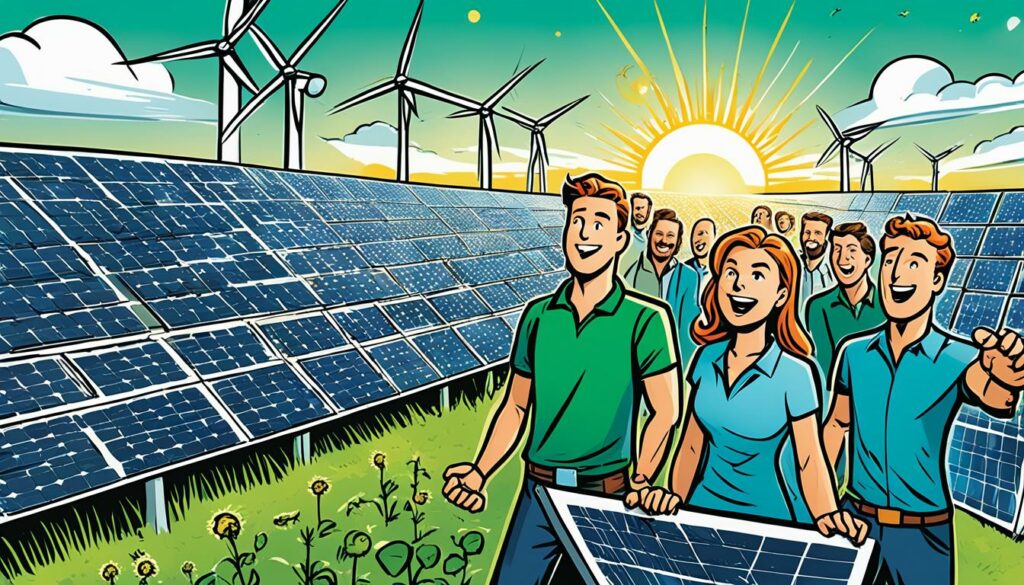
Solar Energy Statistics in the United States
| Data | Statistics |
|---|---|
| Amount of solar energy needed to decarbonize the electricity sector by 2035 | Double the current installation between 2025 and 203022 |
| Technical potential of agricultural land for solar energy capacity | 27 terawatts (a quarter of the total U.S. capacity)22 |
| Expected farmland used for solar energy by 2035 | Only 0.3%22 |
| Research on agrivoltaics by the Solar Energy Technologies Office | Investigating opportunities and trade-offs22 |
| Availability of federal tax credits for solar installations | 30% investment tax credit22 |
| Variation in solar lease payments | Determined by factors like size, location, and negotiated terms22 |
| Considerations for solar developers | Spacing between rows, torque tube height, and racking systems22 |
| Installation of solar in flood plains | Requires electrical equipment to be installed above projected flood levels22 |
This data shows how important solar energy is in the U.S. To reach solar power’s full potential, we must combine growth with environmental and economic care22.
Conclusion
Fixing problems with solar farms needs careful steps and the right tools. One such tool is the Fluke 393 FC Solar Clamp Meter23. This helps with issues like bad wiring, parts getting too hot, and not enough power24.
The future of solar energy is bright, thanks to improvements in technology. Things like better PV efficiency, new storage methods, and making solar power work better25 are key. With hard work, the solar energy industry can grow and be a key source of clean energy25.
